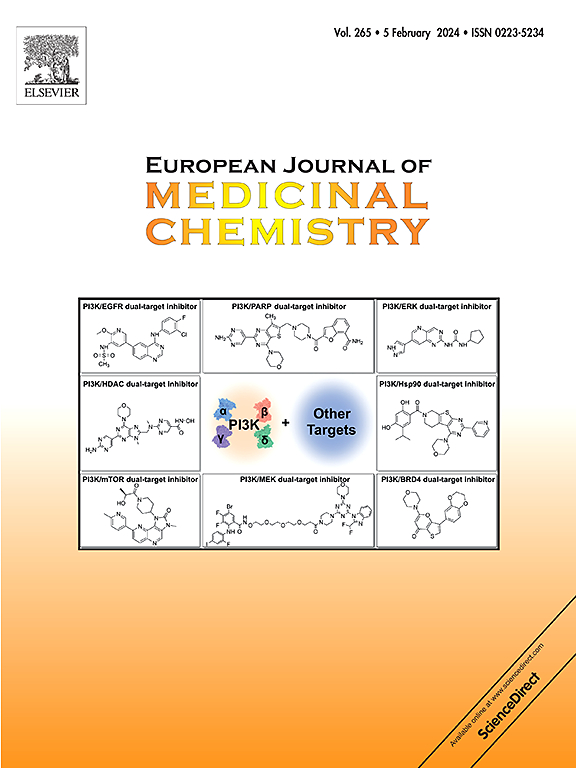通过快速电流脱敏发现具有抗痛觉作用的非亲电 TRPA1 通道激动剂
IF 6
2区 医学
Q1 CHEMISTRY, MEDICINAL
引用次数: 0
摘要
通过激动剂对瞬态受体电位锑蛋白 1(TRPA1)阳离子通道脱敏是开发镇痛药的一种有效策略。许多 TRPA1 激动剂都是亲电刺激剂,包括 BITC 和碘乙酰胺(IA),它们能与通道胞质区域的半胱氨酸残基共价结合。亲电体 JT010 也被认为是一种通过共价修饰 Cys621 的强效 TRPA1 激动剂,其刺激作用已在人体中得到证实,突出了这些亲电激动剂的一个常见不良特性。低温电子显微镜(cryo-EM)结构显示,这些亲电剂通过对 TRPA1 进行亲电修饰,可诱导构象变化的强大驱动力。然而,亲电子诱导的稳定活化构象可能会延迟随后的脱敏,导致体内 TRPA1 介导的痛觉反应延长。因此,开发非亲电性 TRPA1 激动剂可能会通过加速脱敏过程来减轻亲电性激动剂带来的刺激。为了验证这一假设,我们通过去除 JT010 的亲电官能团,设计并合成了一系列新型 TRPA1 激动剂。在这些合成化合物中,通过全细胞膜片钳记录实验发现化合物 21 是一种选择性 TRPA1 激动剂,对 hTRPA1 的 EC50 为 25.47 ± 1.56 μM,与亲电性 JT010(41.71 ± 4.10 秒)和 BITC(68.05 ± 5.57 秒)相比,对 mTRPA1 的脱敏速度更快(τ = 20.02 ± 1.66 秒)。重要的是,化合物 21 对小鼠具有有效的镇痛特性,且无刺激性。我们的研究结果支持这一假设:非亲电通道激动剂可促进 TRPA1 快速脱敏,从而增强抗痛觉效应。化合物 21 有望成为进一步优化的线索。本文章由计算机程序翻译,如有差异,请以英文原文为准。


Discovery of non-electrophilic TRPA1 channel agonists with anti-nociceptive effects via rapid current desensitization
Desensitizing transient receptor potential ankyrin 1 (TRPA1) cation channel through agonists emerges as an effective strategy for developing analgesics. Many TRPA1 agonists are electrophilic irritants, including BITC and iodoacetamide (IA), which covalently bind to cysteine residues in the cytoplasmic region of the channel. The electrophile JT010 is also recognized as a potent TRPA1 agonist via covalent modification of Cys621, whose irritant effects have been confirmed in humans, highlighting a commonly undesirable property of these electrophilic agonists. Cryo-electron microscopy (cryo-EM) structures have shown that these electrophiles induce a strong driving force for conformational change through electrophilic modification of TRPA1. However, the stable activated conformation induced by electrophiles might delay subsequent desensitization, leading to prolonged TRPA1-mediated nociception responses in vivo. Therefore, developing non-electrophilic TRPA1 agonists may mitigate the irritation associated with electrophilic agonists by accelerating the desensitizing process. To test this hypothesis, we designed and synthesized a series of novel TRPA1 agonists by removing the electrophilic functional group of JT010. Among these synthetic compounds, whole-cell patch clamp recording assays identified compound 21 as a selective TRPA1 agonist with an EC50 of 25.47 ± 1.56 μM for hTRPA1, exhibiting faster desensitization (τ = 20.02 ± 1.66 s) of mTRPA1 compared to electrophiles JT010 (41.71 ± 4.10 s) and BITC (68.05 ± 5.57 s). Importantly, compound 21 demonstrated effective analgesic properties without irritation in mice. Our findings support the hypothesis that facilitating rapid desensitization of TRPA1 by non-electrophilic channel agonists enhances anti-nociceptive effects. Compound 21 may serve as a promising lead for further optimization.
求助全文
通过发布文献求助,成功后即可免费获取论文全文。
去求助
来源期刊
CiteScore
11.70
自引率
9.00%
发文量
863
审稿时长
29 days
期刊介绍:
The European Journal of Medicinal Chemistry is a global journal that publishes studies on all aspects of medicinal chemistry. It provides a medium for publication of original papers and also welcomes critical review papers.
A typical paper would report on the organic synthesis, characterization and pharmacological evaluation of compounds. Other topics of interest are drug design, QSAR, molecular modeling, drug-receptor interactions, molecular aspects of drug metabolism, prodrug synthesis and drug targeting. The journal expects manuscripts to present the rational for a study, provide insight into the design of compounds or understanding of mechanism, or clarify the targets.

 求助内容:
求助内容: 应助结果提醒方式:
应助结果提醒方式:


